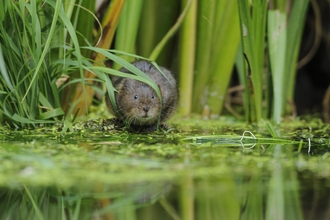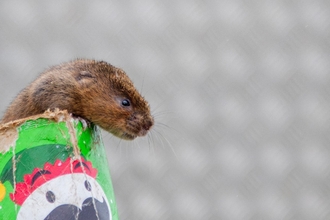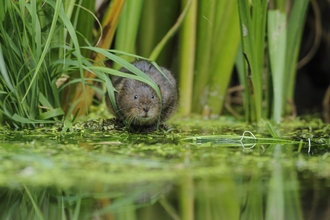A new analysis of data collected over 10 years by a network of experts led by The Wildlife Trusts has revealed that water vole distribution has declined dramatically. There has been a 30% decline in the places where these river mammals once lived across England and Wales during the survey period 2006 - 2015. While the new analysis reveals a slight increase in distribution in recent years – thanks to some successful conservation efforts by The Wildlife Trusts and others – the full data covering the whole 10 years paints a bleak picture.
In recent years Cambridgeshire has a proven healthy population, on reserves and waterways around Peterborough and Cambridge - especially on the Bourn Brook where the Bourn Free project has run since 2011 in collaboration with the Countryside Restoration Trust and the Environment Agency, supported by the local landowners and volunteers. A 2017 survey showed good numbers; Ruth Hawksley, Wildlife Trust Water for Wildlife Officer says: “Water voles only live 2-3 years in the wild and many die over winter, so mild winters allowed more to survive, which might account at least in part for the good numbers found. Wide, grass field margins seem to be important for water vole (and other small mammals) and similarly refuges on river and ditch banks in the city.”
Two years ago a Wildlife Trust BCN report found water voles in encouraging numbers in the Middle Level of the Fens, based on a detailed survey completed in 2015, when Trust staff and volunteers found water voles at least as widespread as previous years - very impressive against a background of national decline. The report drew on information gathered in previous surveys and showed that ditch maintenance by internal drainage boards is critical for water voles, providing an extensive and stable habitat.
Ruth Hawksley said: "Surveying for signs of water vole along Fenland drains is very demanding, but our survey revealed that drains can provide a large connected area of good water vole habitat. Our results support the belief that the Cambridgeshire fens are a regionally, and possibly nationally, important stronghold for water voles."
The Wildlife Trusts work across the UK restore habitats to help water voles and other river wildlife and reintroduce them back to areas where not at risk from mink (for example, last year Northumberland Wildlife Trust released 700 water voles across Kielder Forest – the largest reintroduction ever undertaken).
Nationally The Wildlife Trusts are calling for:
- Government and Local Authorities to enable the creation of a Nature Recovery Network, as set out in the Government’s 25 Year Plan for the Environment. A Nature Recovery Network should be underpinned by a new Environment Act to protect, link and create areas of habitat which help wildlife move and spread out, benefitting water voles and a range of other wildlife. Funding should be increased to expand water vole conservation efforts including for landscape-scale restoration schemes.
- Landowners to manage river bank habitat sympathetically to help water voles, e.g. provide generous buffer strips to provide shelter and feeding areas; create soft edges to river banks for water voles to create burrows in, and avoid using heavy machinery close to the edge of watercourses.
- People to find out about opportunities to help survey water voles or manage riverside habitat with local Wildlife Trusts and other groups involved in water vole conservation.



